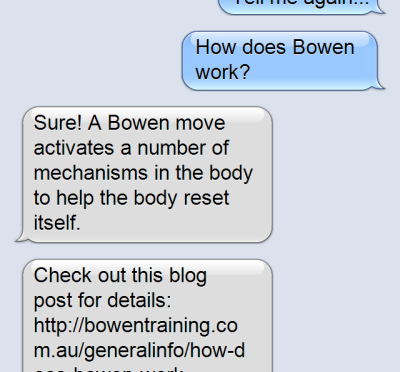A Bowen move activates the following mechanisms to reset the body to heal itself.
1. Stretch reflex — most Bowen moves are done either at the origin, insertion or belly of the muscles where the golgi cells’ receptors are located, informing the nervous systems on the state of tension, length or stretch in the musculotendinous tissue. These receptors are stimulated during the ‘challenge’ and the rolling part of the Bowen move. In case of a pain muscle spasm loop, we can break this vicious circle by changing the stimulus received by the nervous system.
2. Joint Proprioceptors — all Bowen moves done around a joint directly affect the joint capsule and ligaments that are richly enervated with proprioceptors. Here again, stimulus will be received by the nervous system, inviting normalisation of the joint function without the need for forceful manipulation.
3. Fascia — each Bowen move is done at the level of the superficial fascia and affects the relation between the fascia and the nerve, muscle or tendon being mobilised. The fascia plays a major role in muscle coordination, postural alignment and overall structure and functional integrity. All of these will be negatively affected post-injuries, as the fascia will stiffen, contract, torque and dehydrate. Following a Bowen session it is not uncommon to see adhesions loosen up, scar tissue soften, and posture and mobility improve without harsh mobilisation or stretching.
4. Segmental viscerosomatic spinal reflexes — These reflexes are engaged in most basic procedures to produce referred reactions to the internal organs through stimulation of skin and muscles.
5. Autonomic nervous system (ANS) rebalancing — Bowtech™/Bowenwork™ may have its most profound and important effect here where the body’s self-healing mechanisms are governed. The ANS controls more than 80% of bodily functions and is very susceptible to external stressors. Most people today live in a constant state of high stress and sympathetic ANS overstimulation. Healing occurs after the ANS shifts from sympathetic to parasympathetic dominance. The technique seems to catalyse that shift: during sessions, patients often quickly fall asleep or drop into deep relaxation and loud peristalsis can be heard. This indicates a shift towards parasympathetic dominance with release from stress at a deep level. This could explain why a just few Bowen sessions can frequently reactivate the recovery process, where healing from trauma, sickness or surgery has stalled, or reached a plateau.
6. Trigger points — several Bowen moves overlap with recognised trigger point locations. By clearing these trigger points, referred pain can be relieved and joint mobility and muscle coordination improved.
7. Acupuncture points and meridians — most Bowen moves overlap acupuncture points, and some actually cross two or three acupuncture meridians at once. Acupuncturists have correlated the indications and effects of Bowen moves with corresponding acupuncture points. They also comment on the immediate changes of the acupuncture pulses in response to Bowen moves or procedures. The overlap of these two systems could explain the very strong energetic component of the technique and its effect on the internal organs.
8. Neurolymphatic points and lymphatic circulation — Bowen moves overlap the location of many neurolyphatic reflex points that regulate the lymphatic system.
9. ‘Tissue tension’ sense — The Bowen Technique does not use forceful manipulation. A unique skill of the Bowen practitioner is the ’tissue tension’ sense, meaning the practitioners’ ability to discern stress build up in muscles and other soft tissue, enabling them to perform specific Bowen moves to aid recovery.
10. The key to success — There are frequent but very essential pauses throughout the session that allows the body time to respond and begin the healing process.
Printed in Bowen Hands, The Journal of the Bowen Therapy Academy of Australia, March 2015

